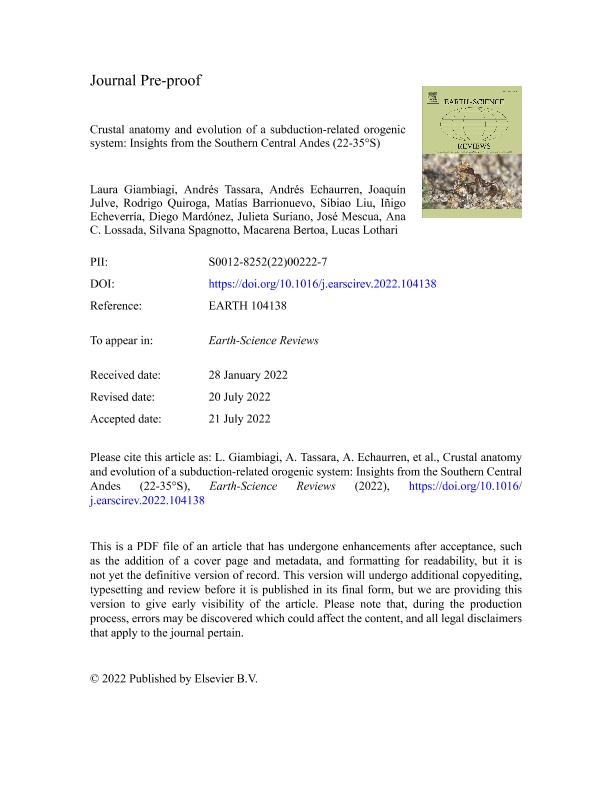Artículo
Crustal anatomy and evolution of a subduction-related orogenic system: Insights from the Southern Central Andes (22-35°S)
Giambiagi, Laura Beatriz ; Tassara, Andrés; Echaurren, Andrés; Julve, Joaquín; Quiroga Carrasco, Rodrigo Adolfo
; Tassara, Andrés; Echaurren, Andrés; Julve, Joaquín; Quiroga Carrasco, Rodrigo Adolfo ; Barrionuevo, Matías
; Barrionuevo, Matías ; Liu, Sibiao; Echeverría, Iñigo; Mardónez, Diego; Suriano, Julieta
; Liu, Sibiao; Echeverría, Iñigo; Mardónez, Diego; Suriano, Julieta ; Mescua, Jose Francisco
; Mescua, Jose Francisco ; Lossada, Ana Clara
; Lossada, Ana Clara ; Spagnotto, Silvana Liz
; Spagnotto, Silvana Liz ; Bertoa del Llano, Macarena
; Bertoa del Llano, Macarena ; Lothari, Lucas Daniel
; Lothari, Lucas Daniel
 ; Tassara, Andrés; Echaurren, Andrés; Julve, Joaquín; Quiroga Carrasco, Rodrigo Adolfo
; Tassara, Andrés; Echaurren, Andrés; Julve, Joaquín; Quiroga Carrasco, Rodrigo Adolfo ; Barrionuevo, Matías
; Barrionuevo, Matías ; Liu, Sibiao; Echeverría, Iñigo; Mardónez, Diego; Suriano, Julieta
; Liu, Sibiao; Echeverría, Iñigo; Mardónez, Diego; Suriano, Julieta ; Mescua, Jose Francisco
; Mescua, Jose Francisco ; Lossada, Ana Clara
; Lossada, Ana Clara ; Spagnotto, Silvana Liz
; Spagnotto, Silvana Liz ; Bertoa del Llano, Macarena
; Bertoa del Llano, Macarena ; Lothari, Lucas Daniel
; Lothari, Lucas Daniel
Fecha de publicación:
09/2022
Editorial:
Elsevier Science
Revista:
Earth-science Reviews
ISSN:
0012-8252
Idioma:
Inglés
Tipo de recurso:
Artículo publicado
Clasificación temática:
Resumen
As the archetype of mountain building in subduction zones, the Central Andes has constituted an excellent example for investigating mountain-building processes for decades, but the mechanism by which orogenic growth occurs remains debated. In this study we investigate the Southern Central Andes, between 22° and 35°S, by examining the along-strike variations in Cenozoic uplift history (<45 Ma) and the amount of tectonic shortening-thickening, allowing us to construct seven continental-scale cross-sections that are constrained by a new thermomechanical model. Our goal is to reconcile the kinematic model explaining crustal shortening-thickening and deformation with the geological constraints of this subduction-related orogen. To achieve this goal a representation of the thermomechanical structure of the orogen is constructed, and the results are applied to constrain the main decollement active for the last 15 Myr. Afterwards, the structural evolution of each transect is kinematically reconstructed through forward modeling, and the proposed deformation evolution is analyzed from a geodynamic perspective through the development of a numerical 2D geodynamic model of upper-plate lithospheric shortening. In this model, low-strength zones at upper-mid crustal levels are proposed to act both as large decollements that are sequentially activated toward the foreland and as regions that concentrate most of the orogenic deformation. As the orogen evolves, crustal thickening and heating lead to the vanishing of the sharp contrast between low- and high-strength layers. Therefore, a new decollement develops towards the foreland, concentrating crustal shortening, uplift and exhumation and, in most cases, focusing shallow crustal seismicity. The north-south decrease in shortening, from 325 km at 22°S to 46 km at 35°S, and the cumulated orogenic crustal thicknesses and width are both explained by transitional stages of crustal thickening: from pre-wedge, to wedge, to paired-wedge and, finally, to plateau stages.
Archivos asociados
Licencia
Identificadores
Colecciones
Articulos(CCT - SAN LUIS)
Articulos de CTRO.CIENTIFICO TECNOL.CONICET - SAN LUIS
Articulos de CTRO.CIENTIFICO TECNOL.CONICET - SAN LUIS
Articulos(IANIGLA)
Articulos de INST. ARG. DE NIVOLOGIA, GLACIOLOGIA Y CS. AMBIENT
Articulos de INST. ARG. DE NIVOLOGIA, GLACIOLOGIA Y CS. AMBIENT
Articulos(IDEAN)
Articulos de INSTITUTO DE ESTUDIOS ANDINOS "DON PABLO GROEBER"
Articulos de INSTITUTO DE ESTUDIOS ANDINOS "DON PABLO GROEBER"
Citación
Giambiagi, Laura Beatriz; Tassara, Andrés; Echaurren, Andrés; Julve, Joaquín; Quiroga Carrasco, Rodrigo Adolfo; et al.; Crustal anatomy and evolution of a subduction-related orogenic system: Insights from the Southern Central Andes (22-35°S); Elsevier Science; Earth-science Reviews; 232; 9-2022; 1-10
Compartir
Altmétricas
Items relacionados
Mostrando titulos relacionados por título, autor y tema.
-
Datos de investigación Modelos cinemáticos de secciones estructurales de los Andes realizadas en software MoveGiambiagi, Laura Beatriz Tassara Oddo, Andres Humberto Echaurren Gonzalez, Andres Julve, Joaquin Quiroga Carrasco, Rodrigo Adolfo Barrionuevo, Matías Liu, Sibiao Echeverria, Iñigo Mardonez Catalán, Diego José Suriano, Julieta Mescua, Jose Francisco Lossada, Ana Clara Spagnotto, Silvana Liz Bertoa del Llano, Macarena Lothari, Lucas Daniel (2023)



